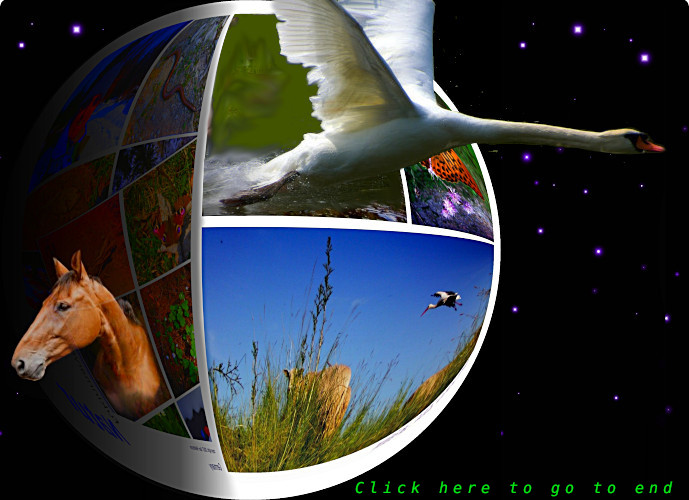
Here's a selection of my wildlife-nature photos taken mainly in Spain, Germany and Taiwan. From an early age I loved nature and photography and by combining both I found the perfect hobby. I use a Nikon D300 and a D5200 with Tamron 18-270mm or Nikkor 18-105mm lens and a Nikon P7700. Maybe not ideal for wildlife and nature photography but as I prefer to travel light and I'm also interested in landscapes, these cameras and lenses are the best affordable compromise.
There is also my wildlife book which can be viewed on YouTube:Wildlife book
Plastic is polluting the world's environment, for more information:Plastic pollution


This photo of a fawn was taken in June 2018 on the Sommerberg plateau in the Black Forest, Germany. I was actually in a hide at the time watching squirrels when a bird landed on the roof of the hide. I poked my head outside to see if I might catch a glimpse of it but instead my attention was drawn to something black twitching below, beside some nearby rocks. When I investigated I came across this fawn well secluded among the rocks. It was the tip of its ear that had first caught my eye, a lucky encounter indeed.

Although the Black Forest is full of wildlife it is not always easy to encounter. You may well get lucky and see deer, hare, buzzards and red squirrels. But there are also more elusive creatures such as wild boar, capercaille and even wolves. Many of the wildlife photos have been taken on the Sommerberg plateau at the northern end of the Black Forest. The plateau has an altitude between 700m and almost 900m and covers an area approx 100 sq km. There are plenty of well marked routes that will take you deep into the heart of the forest. Rivers and streams are few on the plateau but there is a protected nature zone, Wildseemoor with Wildsee, a small lake in the centre.

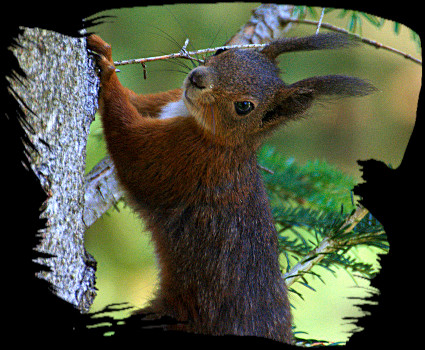
This red squirrel was also photographed while I was in a hide. The squirrel ran down a forest track toward the hide and chose a nearby tree to clamber up. On its way up it stopped to inspect who was lurking inside the hide and in that moment I took three shots. Only one photo came out in 'focus' as I had no time to adjust anything on my camera, which was set at maximum zoom and spot focus for capturing birds. I have noticed two types of squirrels in this forest. Red squirrels like the one above and a much darker species, which could be versions of the black squirrel.

Before my Spanish sojourn and returning to Sommerberg in 2018 I had spent six years previously on the Sommerberg plateau. Since my return I have noticed a sharp decline in butterfies, squirrels and buzzards. I do wonder what is causing this as on the surface it would seem that we are far away from any pollution. We are afterall in what would normally be considered an idyllic location for nature. Clearly trees and forests alone are not the solution to the growing environmental threat to wildlife.

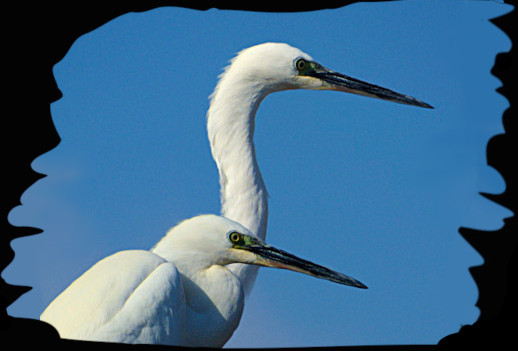
My home in Spain for three years was on the Andalusian coast and much of that time was spent watching egrets. I think they are one of the most beautiful and elegant birds and always a challenge to photograph being brilliant white and especially timid. Most of the egrets I photographed were snowy egrets found along the Rio de Fungirola where usually one or two would be fishing in the river. On rare occasions I had seen up to ten or more in this area. If you can get close to them you are in luck as they do tend to remain very still while peering into the water, allowing plenty of time to be photographed.

The Andalusian coast is interesting for wildlife because of its varied landscape. On the coast there are of course plenty of gulls, waders, cormorants and even parakeets. I also saw less common birds such as a razorbill out at sea, a whimbrel combing a beach and several black-winged stilts on coastal marshland. Inland is mainly scrubland or olive groves reaching to the foothills of the Mijas mountains. Here you may see buzzards, booted eagles, kestrels, waxbills, colourful bee-eaters, hoopoe and numerous other smaller birds. Wild boar are also common in this area though rarely seen apart from maybe a trail of uprooted rocks and damaged lawns left after foraging. During the height of summer the heat can be unforgiving, especially in the outback. So always take water with you!

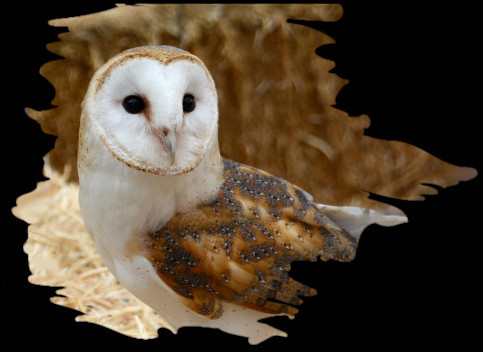
This beautiful barn owl was photographed at a medieval fair in Fuengirola, Spain. It was tethered to a hay bale, patiently observing the spectating crowds and seemingly unruffled by all the fuss. I suppose it is not really wildlife photography, more like photographing animals in a zoo, which I mostly try to avoid. However it was not caged and looked beautifully well kept and seemed quite content with its lot alongside a majestic golden eagle and a huge eagle owl.

Although the Rio de Fungirola in Spain often suffers drought periods, especially in summer there was normally enough water to attract ducks, cormorants and egrets. I have also seen a night heron, several great blue herons and even a little grebe. During storms seagulls would sometimes take refuge on the river, sheltering together on a levee against the wind. A kingfisher, which I photographed a few times, though not particularly successfully, had also found a home on the river.

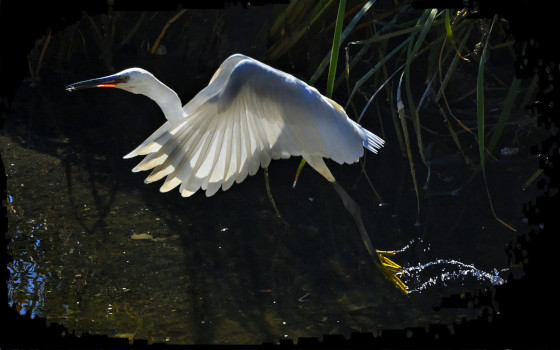
I was lucky with this egret shot as the sun was in front of me, which could have created problems. However the dark background contrasted nicely with the sunlight shining through the egret's wings and a high shutter speed (1/1000 sec @ ISO 500) meant that it was captured frozen in mid-flight as it took to the air. This was taken once again in Spain on the Rio de Fungirola where a nearby levee had created a swamp area that was a particular favourite with egrets.

Although herons are similar to egrets both in size, shape and behaviour they are dramatically different visually. I did on rare occasions see them in Spain but never managed to take a good photograph. However in Pforzheim, Germany I had numerous opportunities to photograph both the grey heron and great blue herons as they were a common feature on the River Nagold and Enz in the heart of Pforzheim city. Cormorants are also quite common and can usually be seen nesting high in the trees or diving for food in the river.

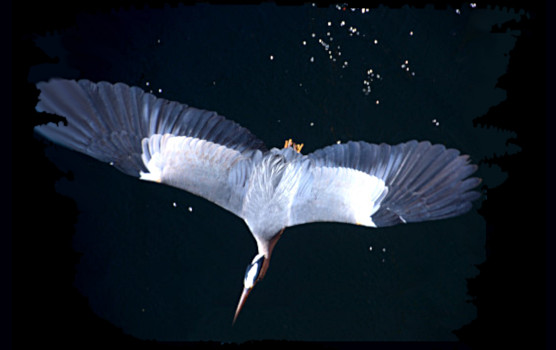
Here a grey heron, photographed in Pforzheim town centre, flies from a river lock under a road bridge I was standing on. The great blue heron is slightly larger and has less white plumage than this more common heron. Grey herons are mostly found either on river banks or standing in shallow waters waitng to spear a fish with their long sharp beaks.

Even in towns and cities it is not unusual to see birds of prey like kestrels, sparrowhawks and even buzzards, but to see them you will have to look up. They maybe perched high on the top ledge of a building or silhouettted against the sky gliding on thermals. Parks are also a good place to visit in search of urban wildlife. The first Malayan night heron that I ever saw was in a park in Taichung, Taiwan and what a strange creature that was, they seem to walk everywhere in slow motion.

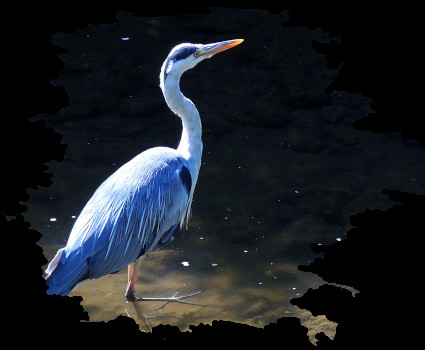
This grey heron was one of the first I ever photographed using a cheap point and shoot, 6mpx Nikon Coolpix camera. The image came out well, largely because the heron was backlit against a dark background. Once again this was taken in Pforzheim and long before I had progressed to a DSLR camera. Proof that you don't always need expensive gear to take good photos.

I lived in Sommerberg village in the Black Forest from 2006-2012. It is a wonderful place for nature photography with its great variety of wildlife and four distinct seasons. Being high up, winters can last almost half the year from October till March and that brings with it plenty of snow and freezing temperatures. Surprisingly this can be one of the most interesting times for watching wildlife as they leave their tracks everywhere in the virgin snow. You can observe fights, animals feeding and even see tracks of animals you would never normally see. Summers can get quite hot and humid with frequent thunderstorms but storms are usually short lived. There are often dramatic cloud formations that occasionally sink into the valley leaving those on Sommerberg above the clouds with spectacular views.


This ram (aka Rambo) I looked after for some years during my stay on Sommerberg. My main task involved feeding hay to Rambo and his flock of ten sheep during winter and rescuing lambs in Spring. Rambo always led the way, while the rest followed dutifully behind, whenever hay was being distributed. As mountain sheep their main role was to keep the grass short on the very steep hillside (gradient 55%) where it was impossible to use machinery or even stand up in places.

Looking after eleven sheep in winter was quite straight foward and just a matter of dishing out hay and stale bread, a favourite treat all round. Come Spring however it could get difficult when lambs were born early or the winter was prolonged. Searching for lost lambs could be quite distressing, particularly for the ewes and quite a number of new born lambs succumbed to the harsh conditions and terrain. In late Spring or early Summer the sheep's heavy woollen winter coats had to be sheered. This was the most challenging task I experienced. Rounding up the sheep was almost impossible mainly due to the terrain. They also sensed something was up and always made sure one of them remained outside the pen we were trying to usher them into. Proof that sheep will only follow up to a point.


This was one of many 'stray' cats I came cross in Spain. Water and food would be left on this wall and cats from all over a local urbanisation would congregate here. Cats can make interesting subjects to photograph as they often assume comical poses. They are nevertheless no different to any other wildlife, being timid and wary of your presence and as such not always easy to photograph. This green-eyed tabby was no different and refused to come out from behind the wall. However sometimes that can make for an interesting photo.

I am particularly fond of butterflies and on my arrival in Taiwan in 2012 I was treated to some of the largest and most spectacular ones I had ever seen. The humid environment produced many large tropical butterflies that endured typhoons during the summer months. I was treated to one typhoon soon after arriving and expected all the butterflies I had seen days before to have been obliterated. Surprisingly however they all reappeared once the typhoon passed and most looked none the worse for the experience. Cicadas on the otherhand were probably the most spectacular insects as their sounds could be so deafening at times it could prevent conversation. I encountered my first large snake during the first weeks. It was a beauty rat snake, about three meters long and thankfully harmless, (although I was unaware of that at the time). Taiwan also had many interesting birds that I had not seen before. All in all it was a fascinating place for nature but at the height of summer the humidity could be unbearable so even being outside in nature was avoided as far as possible.

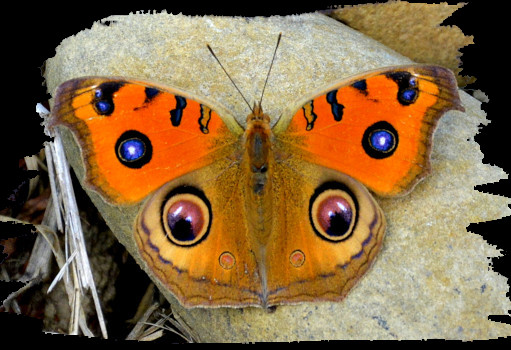
This stunning butterfly known as Junonia Almana or Peacock Pansy is found in India and South East Asia. It is one of the larger varieties found in Taiwan and much easier to photograph being slower in flight than your average butterfly. Generally butterflies are not too difficult to photograph providing you have some patience. From my experience they also seem to be curious and attracted to people provided you remain still. Once I spot a potential target I usually start by taking photos from far off, that ensures that I at least have a record should it flutter off. Then it is a matter of one step foward - photo - one step - photo and so on until I am as close as I wish to be.

Exploring the sub-tropical forests of Taiwan is quite exciting and at times unnerving too. Large snakes lurk in the long grass and giant spiders spin their webs across pathways and between trees making progress difficult at times. There is also the incessant noise from the cicadas, which can be spooky, especially when you see a tree covered in these black alien looking creatures. However hacking your way through long grass, vines and cobwebs does have its attractions. The nature is fascinating and the sound of wildlife comes from all directions. Generally it is pretty safe and I was spared the agonies of mosquito bites and only really had to contend with tiny black midges.


This giant orb weaver spider was photographed on one of my many outings into the forests of Taiwan. It was certainy the largest spider I had ever seen, being about the size of my hand and its web was several meters wide. They have a habit of spinning their webs between trees and have been known to catch birds. Walking into endless cobwebs in forests was unavoidable but I always paid special attention to look out for these Arachnida.

Geckos, lizards and skinks are also a common feature of Taiwan forests and there is a great variety. My favourite was the blue-tailed skink, which like the kingfisher was rarely seen but for a fleeting flash of iridescent blue. Despite being quite common, I chased these creatures for over a year before getting a halfway acceptable photo of one. They are similar to geckos and lizards both in colour, size and shape except for their bright blue tails which are unmistakeable and designed to snap off and grow back if caught by a predator.


This small gecko was probably the most common type to be found where I was in Taiwan. They were everywhere, even in my home climbing up the smooth painted walls. Like squirrels they are very quick and agile through trees but do occasionally stop and freeze making photos possible. If I remember correctly, the difference between lizards and geckos is, one has ears and eyelids and the other has neither. Don't ask me which.

Meanwhile back in the Black Forest, before I had left for Taiwan, there was a marshy area that I frequently visited. Rainwater had collected in the tracks left by heavy forest vehicles and formed small pools, which supported a variety of pondlife. In Spring frogs, toads and newts laid their spawn in them and by May there would be thousands of tadpoles and frogs. Smooth newts could also be found here, although they were less common. This life-cycle happened every year without fail between 2006 - 2012, so I was surprised when I returned in 2018 to find that all these areas had dried up and no tadpoles had survived.

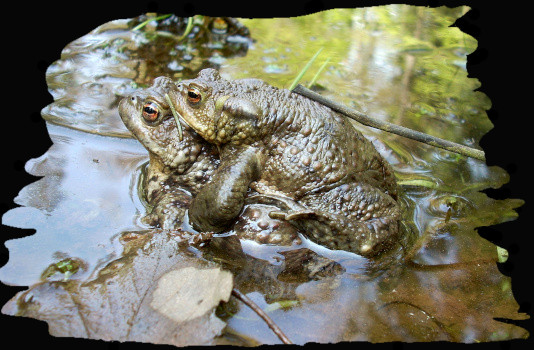
These two frogs enjoying life were photographed in the marshy area I describe in the last paragraph. However as mentioned already there was no water to be found in this area in 2018 so this photograph dates back to the period 2006-2012. It may just have been a particularly mild winter this time combined with a lack of rain in Spring that caused the drought but it certainly demonstrates how vunerable wildlife is to changing weather patterns.

Lack of rain water was never a problem in Taiwan especially after a typhoon. It could rain heavily for three days non-stop during typhoons, resulting in flash floods and chaos everywhere. Fortuneatly most typhoons headed for Taiwan were deflected by the high mountain range that runs north to south. Most tended to move on northwards towards Japan. Taiwan would still experience a handful each year but mainly concentrated along the east coast.


A large grasshopper on the wire fence of a tennis court in Taiwan. There was no end to the variety of insects in Taiwan and many of those I was already familiar with, like this grasshopper, came in XXL format. I only had a few minor encounters with mosquitoes, but after a typhoon or heavy rainfall I often had to extract one or two roaches that had taken refuge in my home. However the worst offenders were plagues of tiny black flies or midges that would silently bite leaving itchy spots and buzz around my head when reading or working on my computer. This was very distracting and often prevented me from working or enjoying reading a book.

Once the Taiwan summer had passed and humidity restored to something more bearable, air conditioning and dehumidfiers can finally be switched off. I say finally because during the summer months the whole country vibrates to the incessant sound of air-conditioning units 24/7. However, from November until May the weather is usually perfect and still warm enough to provide plenty of insect life. In fact as Taiwan's seasons are generally always wet and warm it is possible to grow vegetables and fruit two or three times a year.

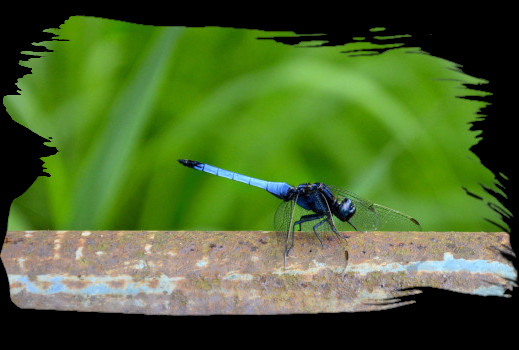
A blue dragon fly caught napping. There is a wide variety of mayflies and dragonflies in Taiwan, some small, some large and almost all reflecting beautiful iridescent colours. They are commonly found alongside rivers and in areas with lakes and ponds. Anisoptera are one of the hardest insects to photograph as they rarely stay still for long and can be difficult to see. In fact I think this photograph is one of only a handful that I have ever taken.

Although much of the arable Taiwanese landscape is taken up by rice fields there are still plenty of meadows with wild flowers and long grass. The shallow water in the rice fields also attracts plenty of egrets, which can often be seen flocking behind tractors as they prepare the fields for the next harvest. Taiwan is split down the middle from north to south by an almost impassable mountain range as high as the Alps. Unlike in the Alps, here forests reach the summits and even in mid-winter snow is rarely seen except on the very highest peaks. Jungle-like forests cover the steep sided valleys and wide rivers fill the basins. It is a spectacular landscape and very different from typical mountain scenes with ice, snow and rock faces. Small exotic birds inhabit these forests and the unremitting sounds of the cicadas fills the air.


A honey bee inspects a wildflower in a meadow in Taiwan. A wide variety of wild flowers can be found in the meadows and along river banks. Much of the wild landscape is covered by bamboo forests, long grass, large leaf banana-type plants and bulrush.

One of the most interesting places I visited in Taiwan was the Aowanda national forest park. This is in the heart of the central mountains with spectacular scenery and bird life. The steep forested valleys are home to a variety of wildlife and not far to the south I was told there is an area inhabited by monkeys. The Formosan rock macaque or rock monkey is endemic to Taiwan but on this occasion I was unable to visit that area, at least I had once experienced the cheeky Gibraltar rock monkeys in Europe some years ago.

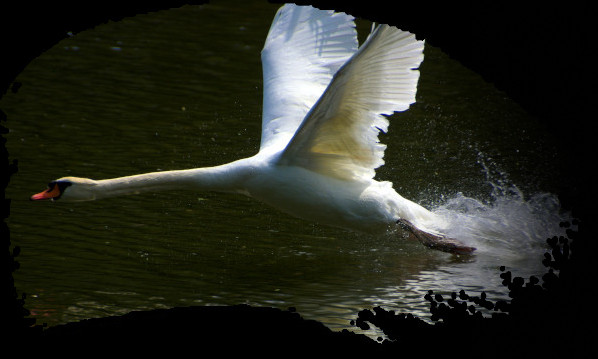
A mute swan takes off from the River Nagold in Pforzheim, Germany. This was shot at 1/1500sec, 400 ISO using point focus and AF/C. Much like Jumbo jets, these large birds require quite a run up to get airborne and it can be quite a noisy and spectaular event to watch. It's in complete contrast to their usual behaviour of looking down their beaks as they glide serenely and elegantly past neighbouring ducks. I get the feeling they are a little embarrassed by their take off style and try best to avoid it as it is a relatively seldom sight.

Generally people tend to think of the countryside when it comes to nature and wildlife but there are still a surprising variety of birds and animals to be found in towns and cities. You do have to be on the lookout and curb the temptation of looking into shop windows. Most towns and cities have rivers running through them, which are usually teaming with all sorts of wildlife and don't forget the parks.

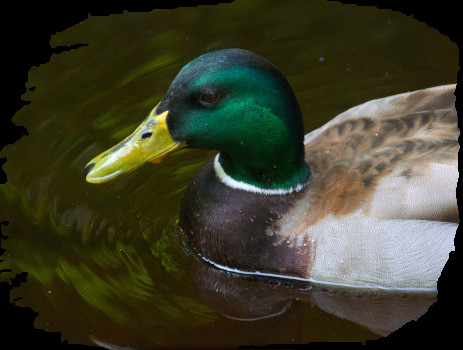
Even the common mallard duck, which can be seen on every pond and lake in every town and city can be a wonder to behold when seen close up with the sun's rays dancing off the green sheen of its head feathers. The mallard or wild duck has some of the most interesting colours and patterns of any bird even down to its perfectly curled tail feather, which I have not seen on any other bird. Because we see them all the time we tend to take them for granted and not take too much notice of them but next time you see one take a closer look.

Whenever walking through woods, meadows or parks, stop occasionally and look around. Nature and wildlife is everywhere and should be almost impossible to miss. However if you are deep in thought, talking or looking for, or at something in particular it is easy to pass it all by without noticing anything. We look but do not see, we hear but do not listen, as was once said by some philosopher.

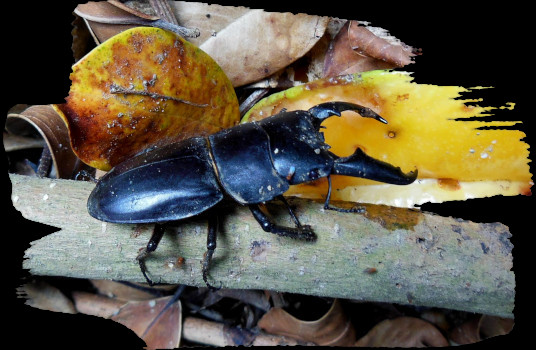
This stag beetle feeding on fallen starfruit I spotted on a path I was walking on. Pathways like these covered in leaves, twigs and fallen fruit often attract a wide variety of insects as well as geckos, lizards and snakes. Careful where you tread and always keep a wary eye open for any movement that might indicate a creature of some sort.

I will return now to Spain for the final photos and reflect on some aspects of photography. Owing to the relatively hot climate much of the Spanish interior is scrubland and even desert with many dried out river beds. Despite that the landscape can still be spectacular with many olive groves and traditional white-painted villages contrasting with the red sunbaked earth that covers much of the land. Having spent most of my time on the coast I am not too familiar with the wildlife of the interior but you can be sure there is plenty to be found, particularly as many of these areas are sparsly populated. A great photo can be made in just about any situation, it is just a question of seeing things in a new light.


A turtle keep fit club maybe, who knows. These four guys were photographed early in the morning on the Rio de Fungirola. This river was very popular with turtles and they could be seen most days sunning themselves on the slopes of a conrete levee or on rocks in the river. They had to compete with large grey mullet, coots, ducks and moorhens but they all seemed to get along fine. At least until bread was thrown into the river from a bridge by passersby. Then the ducks and fish would fight for the prized morsels and usually the fish won.

I always find it best to travel alone when taking wildlife photos. It is all too easy when walking with others to get into conversation and get distracted. Also it disturbs the wildlife and if you are on your own you can be focused on one thing and pursue it. My philosophy of 'less is more' is relevant here too, as well as with camera gear or life style choices.

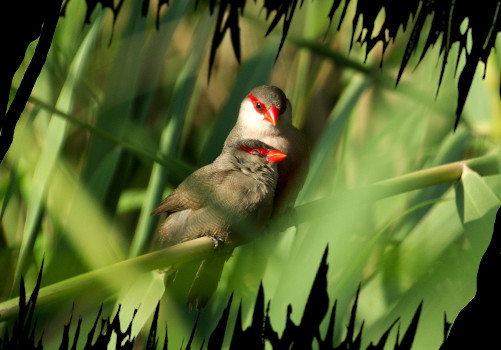
Hidden deep in long grass beside a river a pair of waxbills or maybe I should call them lovebirds seemed oblivious to me as I approached. They were so engrossed in each other that I got quite close, giving me time to choose settings on my camera. These tiny, energetic birds are quite hard to spot and being nervous seem to prefer flying in groups from one spot to another. This pair were otherwise preoccupied as the male seemed to spend most of its time preening the female, much to her obvious satisfaction.

The secret to a good wildlife photo is not always trying to get that snap of a rare encounter but rather the setting in which you find any creature. You may have captured a flamingo in perfect flight but what about the background. Do you really need a long lens so that all you see is the bird or animal. The background is just as important as it gives an image context. Virtually all wildlife has now been perfectly portrait photographed a millions times already. Consider other aspects, such as the environment, light, background.

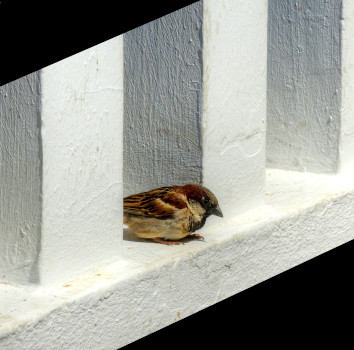
Even a house sparrow can have its photogenic moments. Never ignore a subject just because it is common. A blackbird may be wrestling with a snail or a duck about to take to the air. Always be ready for that unique moment that can turn the mundane into a classic image.

Finally some photo tips. Travel light, keep things simple and try to stay focused. The more gear you carry, whether that be a tripod or extra lenses, the more restricted your movements will become and it just complicates the whole process. Even setting up a tripod can result in missing something. Once a camera is mounted to a tripod you have lost some of the freedom to shoot where you like. Check your camera settings before leaving and the batteries. Always take a spare battery. Whenever you see something interesting stop. Check the direction of the wind. If you are downwind OK, walk slowly towards your subject avoiding noisy gravel tracks and dry leaves. I think camoflage clothing is overrated, it may help a little but I am pretty sure that most wildlife are alerted by movement and not by a bright red sweater. Always move slowly stopping intermittantly to check on the subjects reaction to you. Sometimes the only course of action is to remain still for long periods. Remember as soon as you enter any area insects are alerted, they in turn alert the birds and the birds the animals. Only by staying still for long periods will the wildlife return to its normal activity. Always take water, a snack and umbrella with you. Good luck, have fun and thanks for taking time out to read this!

